Arts
A silver line in the arena of commercial films
`Once upon a time' - Sanath Goonatilaka's maiden
directorial venture:
by Indeewara THILAKARATHNE and Ranga CHANDRARATHNE
Given the heap of collective weaknesses inherited by Sri Lankan
cinema, `Once upon a time', Sanath Goonatilake's maiden directorial
venture, has become an above average commercial film with its
traditional ingredients such as love, hatred and tragedy. Compared with
cheap fantasies such as Aba, `Once upon a time' has set a healthy trend
in commercial cinema in which, at least, the director attempts to treat
the subject matter of the work in an artistic manner. The film would
have been a more meaningful experience for the audience if the director
had exploited Emile Zola's short story which provided the material for
the film, to the maximum, translating it into a cinematic verse. It is
the tragedy of the man which should have been explored instead of him
becoming the but-end of ridicule.
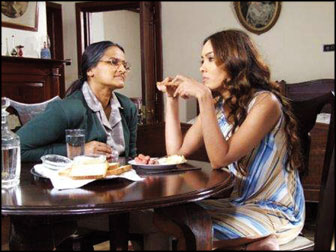 The film commences in a pan which moves from left to right capturing
the image of an old mansion in the hill country. A boy and a girl play
in the green in front of the mansion. The backdrop of the film seems to
be in the nineteenth century. Then the frames move from flashback to the
present. The film commences in a pan which moves from left to right capturing
the image of an old mansion in the hill country. A boy and a girl play
in the green in front of the mansion. The backdrop of the film seems to
be in the nineteenth century. Then the frames move from flashback to the
present.
The boy, who is the son of the governess of the mansion, has now
become a lawyer while the girl, the only heiress of the mansion, has
become an accomplished beautiful maiden. In a scheme hatched by the
Governess, the boy is commissioned to give piano lessons to the maiden.
Eventually they became passionate lovers. Meanwhile a lonely office
worker with no relations of his own harbours a secret longing for the
girl. Following a series of events, the story ends in tragedy.
Sanath Goonatilaka's maiden directorial venture should be commended
for it has been able to surpass aesthetic quality of mega-budgeted `epic
films' such as Aba. Compared to Aba Sanath has been able to narrate a
striking story though in a superficial manner. Especially given its
intimate depiction of love between the boy (Roshan Ravindra) and the
girl (Nirosha Perera), `Once upon a time' is poised to be a commercial
success.It has also surpassed many commercial films in terms of
selection of material for the film. However, Sanath Goonatilake could
not escape from heap of weaknesses inherent to Sri Lankan art in general
and cinema in particular.
Opting to take up the lead role which is that of the office worker,
Sanath has failed to derive the profound human tragedy in the character.
Due to a series of weaknesses on the part of camera, laying of music and
the poor syntax of the visuals, the director has failed to exploit the
very dramatic quality of otherwise brilliant plot.
For instance, even the logical evolution of love between the boy and
the girl has not been achieved. Dr. Premasiri Khemadasa's music has not
been integrated into the visual narration. In an ideal scenario, the
music scores should be integrated into the very soul of the film so as
they become an auditory character. Since the lighting, grammar of
visuals together with the very tempo of acting have not been
synchronised which is a part of the baggage of inherent weaknesses that
Sanath has to carry on, the intensification of zest; moods such as
sadness and melancholy seems rather artificial. Like on many aspects,
the film is very weak in the composing of music. In fact, the laying of
music scores have not been integrated into the very soul of the film. It
is felt throughout the film that music scores would not emanate from the
visuals instead they run in parallel or at a superficial level. It is
pity that Sri Lankan film makers have failed to learn from films like "Nidhanaya"
and "Golu Hadawatha" or "Delovak Athara". Though music scores were
impressive, they have not been integrated into the narration. It is the
defects in the direction and cinematography which rendered music scores
irrelevant.
Music
Sri Lankan cinema has not explored immense potentials of music. It
has been reduced to mere laying of music scores. The music does not
emanate from the visuals. This weakness is also evident in this film.
For instance, when the lonely office worker plays a flute, the
melancholy tone of the tune should have been a defining characteristic
of that personality. In fact, he expresses himself through the flute.
"The Kreutzer Sonata", a novella published in 1889 by Leo Tolstoy based
on the Beethoven's piece is an example of how people can be led astray
by their unruly passions.
However, when it comes to cinema, music should become a powerful
force of expression. In a broader perspective, a film can be a symphony.
Three Colours Trilogy (Blue/White/Red-1994) of Krzysztof Kieslowski can
be cited as examples. `Once upon a time' has also failed to grasp the
tempo of the short story. The reporting-style narration in the film can
also be seen in music. For instance, music scores have been integrated
in films like "Nidhanaya", "Golu Hadawatha", "Para Dige" and even in "Rekhawa"
in addition to absorbing heart-beat of life in Sri Lanka and the rhythm
of our soil. They were equally earned universal admiration for their
rich aesthetic quality and the language of cinema.
Pivotal character
One of the weaknesses in terms of characterisation is that the
director has not identified the very nature of the roles. For instance,
Sanath Goonatilaka is, in fact, not suitable for the character of a
lonely office worker. Portrayal of the character not as complex
personality, who leads a miserable life evoking pity and sympathy of the
audience but as a hilarious character from the very first frame, is a
failure on the part of the director. Music expression in the character
especially in the flute music should be an emotion-studded piece
encapsulating pure nature of love.
None of the characters in the film has been evolved. It is obvious
that the central character of the film is the lonely office worker and
the other characters are to reflect on diverse aspects of his character.
Chandani Senevirathne, who played the role of the Governess, excelled in
the portrayal of the character. Roshan Ravindra has also played his
allotted role well. The main actress (Nirosha Perera) though could not
express subtle nuances, she has done justice to the role to a certain
extent.
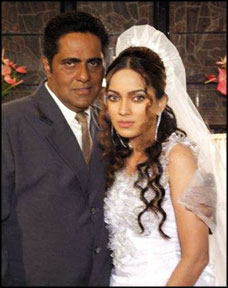 Semini Iddamalgoda as a wife of the family is a complete failure.
Even as an old lady, she looks like a young woman. Though the make up
artist, also has to share the blame, principally Semini has failed to
portray the character. Semini Iddamalgoda as a wife of the family is a complete failure.
Even as an old lady, she looks like a young woman. Though the make up
artist, also has to share the blame, principally Semini has failed to
portray the character.
Selection of actors and actresses and specially a person with a
suitable figure for a character is as important as the personality of
the actor or actress. For instance, Ashoka Handagama's selection of an
actress for the role of lady magistrate in the film `Aksharaya' can be
cited as an example for casting persons with suitable figures. Pans in
the film were used rather awkwardly rendering absolutely no meaning to
the visual narration or cinematography. However, in Sumithra Peries'
film`Yahaluwo', pans were used profitably to intensify the zest and to
highlight another perspective of the storyline.
When a critic shows defects in a film, it is not the intention of the
critic to bring the film maker or his creation into disrepute. For
instance, thousands of awards could not light up the poor texture in the
tele-drama Karuwala Gedara due to it being flatly under-lit. We are
unfortunate as a nation not to recognise wide ranging character
brilliantly portrayed by Wasanthi Chaturani in the tele-drama
Sathgunakaraya yet. In a highly politicised culture, critics have been
threatened, sometimes, with death and unleashed armed goons upon them.
Depriving nation of a healthy culture of criticism where critics like
Reggie Siriwardene, Benedict Dodampegama, Gamini Hathtthotuwegama,
Jayawilal Wilegoda, A. J. Gunawardene and Ajith Samaranayake flourished
leading to the production of films such as "Gamperaliya" which has rated
second in popularity in France, Mecca of film industry. Unfortunately,
that rich culture of criticism does not prevail instead film makers,
actors and actresses have become re-active without being creative and
being imbibed in cronyism where favourites' works are praised to the
moon.
Since Sanath's attempt is commendable and was able to come out with
an above average film based on celebrated short story, it is hoped that
he should immediately commence work on his next film looking back on
"Once upon a Time" from a positive perspective. Although the director
intended to include Buddhist philosophical outlook on life as a sub-text
in the film, his attempt has not been fruitful as in Ketan Mehth's 'Colours
of Passion 'based on the life of 19th century controversial artist Raja
Ravi Varma. This film should be on the must-watch list of the audience
as it stands out among the forced- to- watch monumental cinematic
blunders.
Raigam Tele drama judges felicitated
by Ananda KANNANGARA
The Raigam Marketing Services which sponsored the `Raigam Tele
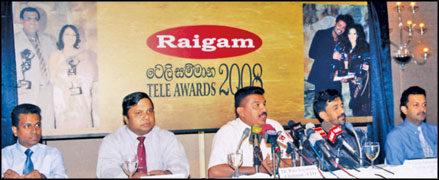 |
|
The organisers of the `Raigam Tele
Awards’ felicitated the panel of judges and award winning
artistes at a ceremony in Colombo on Tuesday. from (L to R)
Finance Director Prashantha Nanayakkara, MD, Ganaka
Amarasinghe, Chairman Dr. Ravi Liyanage, Chairman of the
Panel of Judges Dr. Patrick Rathnayake and Deputy Chairman
Kishan Theodore. (Pix. by Wimal Karunathillaka) |
Awards' - 2008 ceremony at the BMICH on May 15, held a get-together
in Colombo last Thursday to felicitate the panel of judges who adjudged
the best teledrama of the year and the award winners.
Dr. Patrick Ratnayake, Dr. Ajantha Hapuarachchi, Mrs. Jayantha
Siriwardana, Chandrasiri Bogamuwa and Visharada Edward Jayakody were the
members of the panel. The organisers, Raigam Marketing Services (RMS)
also invited the artistes, musicians and technicians who were awarded at
the Tele Awards Ceremony on May 15, held under the patronage of Prime
Minister Rathnasiri Wickramanayake.
Speaking on the occasion, RMS, Chairman Dr. Ravi Liyanage highlighted
the difficulties faced by them when organising such a huge ceremony and
thanked the panel of judges for their invaluable contribution by
watching all teledramas, telecast on television channels during the year
2008 to select the best teledrama and the winning artistes including
directors, actors, actresses, producers and technicians.
RMS, Managing Director Ganaka Amarasinghe mentioned touching on next
year's sixth Tele Awards Ceremony said that the organising committee has
decided during the month of March and present more awards in order to
encourage many more artistes.
He also specially thanked to the best tele drama actor of the year
Janak Premalal and actress Nilmini Tennekoon for their performances in `Karuwala
Gedara' and `Handawa' teledramas.
Thailand donates a magnificent Golden Buddha statue
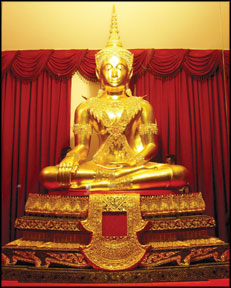 |
|
Golden Buddha statue |
Thailand has gifted a fourteen feet high golden Buddha statue to
Nagarukkarama, Kotikawatta in response to a request made by Ven.
Saddharma Keerthi Shree Badulle Mahanama Thera recently.
The statue will be unveiled on June 6, followed by the reposition of
relics from 7, 8 and 9 June.
The valuable statue which depicts the image of `subduing Mara' is
claimed to be a mix of Ghandarwa and Thai cultures.The statue belonged
to Ven. Phrakrasamu Jirayu Atchichanto, Mahanayaka Thera.
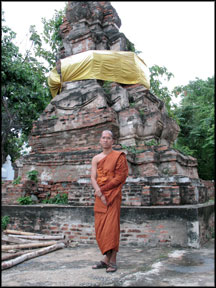 |
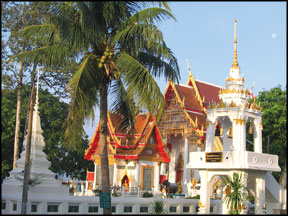 |
| Saddharma
Keerthi Shri Badulle Mahanama Thera |
Wat Tar-En temple,
Ayuthya, Thailand |
|

